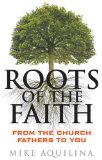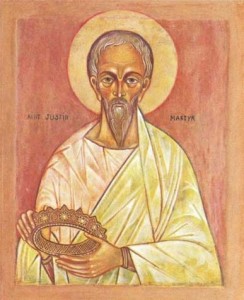[powerpress]
From a letter to the Ephesians by Saint Ignatius of Antioch, bishop and martyr
(Nn. 13-18,1: Funk 1, 183-187)
Have Faith in Christ, and love
Try to gather together more frequently to give thanks to God and to praise him. For when you come together frequently, Satan’s powers are undermined, and the destruction that he threatens is done away with in the unanimity of your faith. Nothing is better than peace, in which all warfare between heaven and earth is brought to an end.
None of this will escape you if you have perfect faith and love toward Jesus Christ. These are the beginning and the end of life: faith the beginning, love the end. When these two are found together, there is God, and everything else concerning right living follows from them. No one professing faith sins: no one possessing love hates. A tree is known by its fruit. So those who profess to belong to Christ will be known by what they do. For the work we are about is not a matter of words here and now, but depends on the power of faith and on being found faithful to the end.
It is better to remain silent and to be than talk and not be. Teaching is good if the speaker also acts. Now there was one teacher who spoke, and it was made, and even what he did in silence is worthy of the Father. He who has the word of Jesus can truly listen also to his silence, in order to be perfect, that he may act through his speech and be known by his silence. Nothing is hidden from the Lord, but even our secrets are close to him. Let us then do everything in the knowledge that he is dwelling within us that we may be his temples, and he God within us. He is, and will reveal himself, in our sight, according to the love we bear him in holiness.
Make no mistake, my brothers: those who corrupt families will not inherit the kingdom of God. If those who do these things in accordance with the flesh have died, how much worse will it be if one corrupts through evil doctrine the faith of God for which Jesus Christ was crucified? Such a person, because he is defiled, will depart into the unquenchable fire, as will anyone who listens to him.
For the Lord received anointing on his head in order that he might breathe incorruptibility on the Church. Do not be anointed with the evil odor of the teachings of the prince of this world, that he may not lead you captive away from the life that is set before you. But why is it that we are not all wise when we have received the knowledge of God, which is Jesus Christ? Why do we perish in our stupidity, not knowing the gift the Lord has truly sent us?
My spirit is given over to the humble service of the cross which is a stumbling block to unbelievers but to us salvation and eternal life.
Excerpts from the English translation of The Liturgy of the Hours (Four Volumes) © 1974, International Commission on English in the Liturgy Corporation. All rights reserved.

This entry was posted on Tuesday, January 20th, 2015 at 12:21 pm
You can follow any responses to this entry through the RSS 2.0 feed.
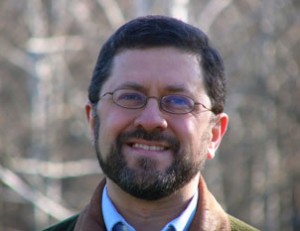 Take a listen to our  conversation with Mike Aquilina about St. Anthony, Church Father
Take a listen to our  conversation with Mike Aquilina about St. Anthony, Church Father
[powerpress]
A quote from St. Anthony:
“I saw the snares that the enemy spreads out over the world and I said groaning, “What can get through from such snares?” Then I heard a voice saying to me, “Humility.”
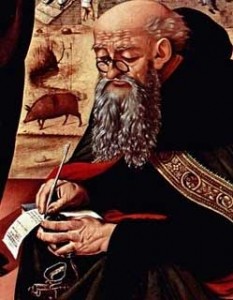 St. Anthony of the Desert, or St. Anthony the Abott, or St. Anthony the Great…no matter what you may call him, he is above all…a SAINT!
St. Anthony of the Desert, or St. Anthony the Abott, or St. Anthony the Great…no matter what you may call him, he is above all…a SAINT!
Saints SQPN.com – Following the death of his parents when he was about 20, Anthony insured that his sister completed her education, then he sold his house, furniture, and the land he owned, gave the proceeds to the poor, joined the anchorites who lived nearby, and moved into an empty sepulchre. At age 35 he moved to the desert to live alone; he lived 20 years in an abandoned fort.
Anthony barricaded the place for solitude, but admirers and would-be students broke in. He miraculously healed people, and agreed to be the spiritual counselor of others. His recommendation was to base life on the Gospel. Word spread, and so many disciples arrived that Anthony founded two monasteries on the Nile, one at Pispir, one at Arsinoe. Many of those who lived near him supported themselves by making baskets and brushes, and from that came his patronage of those trades.
Anthony briefly left his seclusion in 311, going to Alexandria, Egypt to fight Arianism, and to comfort the victims of the persecutions of Maximinus. At some point in his life, he met with his sister again. She, too, had withdrawn from the world, and directed a community of nuns. Anthony retired to the desert, living in a cave on Mount Colzim.
Descriptions paint him as uniformly modest and courteous. His example led many to take up the monastic life, and to follow his way. Late in life Anthony became a close friend of Saint Paul the Hermit, and he buried the aged anchorite, leading to his patronage of gravediggers. His biography was written by his friend Saint Athanasius of Alexandria.
His relationship with pigs and patronage of swineherds is a little complicated. Skin diseases were sometimes treated with applications of pork fat, which reduced inflammation and itching. As Anthony’s intervention aided in the same conditions, he was shown in art accompanied by a pig. People who saw the art work, but did not have it explained, thought there was a direct connection between Anthony and pigs – and people who worked with swine took him as their patron. –Saints SQPN.com
Tags: catholic, catholic podcast, catholic prayer
This entry was posted on Saturday, January 17th, 2015 at 12:00 pm
You can follow any responses to this entry through the RSS 2.0 feed.
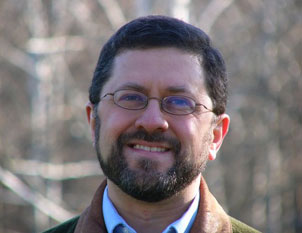 Episode 1 – Witnesses to Tradition. A grand overview of Church tradition as passed down to us by the Fathers of the Church…it’s scope and relevance for our lives today!
Episode 1 – Witnesses to Tradition. A grand overview of Church tradition as passed down to us by the Fathers of the Church…it’s scope and relevance for our lives today!
[powerpress]
Roots of the Faith – From the Church Fathers to You with Mike Aquilina, makes clear that just as an acorn grows into a tree and yet remains the same plant, so the Catholic Church is a living organism that has grown from the faith of the earliest Christians into the body of Christ we know today. Hosted by Kris McGregor
Also visit Mike’s “Discerning Hearts” page for more audio downloads and information!
This entry was posted on Thursday, December 11th, 2014 at 6:12 am
You can follow any responses to this entry through the RSS 2.0 feed.
What is old is new again. That’s why the Fathers are so important, they’ve done battle with the heresies that continue to plaque our Church even today. Also in his writings you can see the “Theology of the Body”…1800 years or so before we hear from Pope John Paul II. Faith and Reason can live in harmony…then knew it then and we can be confident about that now.
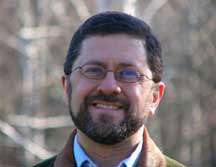 Take a listen to Mike Aquilna, who does a great job giving us the life of this early, early father of the Church, Clement of Alexandria.
Take a listen to Mike Aquilna, who does a great job giving us the life of this early, early father of the Church, Clement of Alexandria.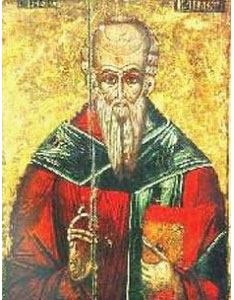
[powerpress]
Here in a very small nutshell is an overview of St. Clement of Alexandria –
from wikipedia –
Titus Flavius Clemens (c.150 – c. 215), known as Clement of Alexandria (to distinguish him from Clement of Rome), was a Christian theologian and the head of the noted Catechetical School of Alexandria. Clement is best remembered as the teacher of Origen. He united Greek philosophical traditions with Christian doctrine and valued gnosis that with communion for all people could be held by common Christians specially chosen by God.Though he constantly opposes the concept of gnosis as defined by the Gnostics, he used the term “gnostic” for Christians who had attained the deeper teaching of the Logos.He developed a Christian Platonism. He presented the goal of Christian life as deification, identified both as Platonism’s assimilation into God and the biblical imitation of God.
Like Origen, he arose from Alexandria’s Catechetical School and was well versed in pagan literature.Origen succeeded Clement as head of the school.Alexandria had a major Christian community in early Christianity, noted for its scholarship and its high-quality copies of Scripture.
Clement is counted as one of the early Church Fathers. He advocated a vegetarian diet and claimed that the apostles Peter, Matthew, and James the Just were vegetarians. – wikipedia
Great trilogy of St. Clement of Alexandria
The trilogy into which Clement’s principal remains are connected by their purpose and mode of treatment is composed of:
- the Protrepticus (“Exhortation to the Greeks”)
- the Paedagogus (“Instructor”)
- the Stromata (“Miscellanies”)
The first book deals with the religious basis of Christian morality, the second and third with the individual cases of conduct.
Tags: alexanderia, Church, clement of alexandria, early church fathers, faith and reason, father, father of the church, fathers mike, fathers of the church, gnostics, heresy, mike aquilina, Mike Aquilna
This entry was posted on Thursday, December 4th, 2014 at 8:26 am
You can follow any responses to this entry through the RSS 2.0 feed.
[powerpress]
A commentary on the Diatessaron by St Ephrem
Keep watch: He is to come again
To prevent his disciples from asking the time of his coming, Christ said: About that hour no one knows, neither the angels nor the Son. It is not for you to know times or moments. He has kept those things hidden so that we may keep watch, each of us thinking that he will come in our own day. If he had revealed the time of his coming, his coming would have lost its savour: it would no longer be an object of yearning for the nations and the age in which it will be revealed. He promised that he would come but did not say when he would come, and so all generations and ages await him eagerly.
Though the Lord has established the signs of his coming, the time of their fulfilment has not been plainly revealed. These signs have come and gone with a multiplicity of change; more than that, they are still present. His final coming is like his first. As holy men and prophets waited for him, thinking that he would reveal himself in their own day, so today each of the faithful longs to welcome him in his own day, because Christ has not made plain the day of his coming.
He has not made it plain for this reason especially, that no one may think that he whose power and dominion rule all numbers and times is ruled by fate and time. He described the signs of his coming; how could what he has himself decided be hidden from him? Therefore, he used these words to increase respect for the signs of his coming, so that from that day forward all generations and ages might think that he would come again in their own day.
Keep watch; when the body is asleep nature takes control of us, and what is done is not done by our will but by force, by the impulse of nature. When deep listlessness takes possession of the soul, for example, faint-heartedness or melancholy, the enemy overpowers it and makes it do what it does not will. The force of nature, the enemy of the soul, is in control.When the Lord commanded us to be vigilant, he meant vigilance in both parts of man: in the body, against the tendency to sleep; in the soul, against lethargy and timidity. As Scripture says: Wake up, you just, and I have risen, and am still with you; and again, Do not lose heart. Therefore, having this ministry, we do not lose heart.
Excerpts from the English translation of The Liturgy of the Hours (Four Volumes) © 1974, International Commission on English in the Liturgy Corporation. All rights reserved.
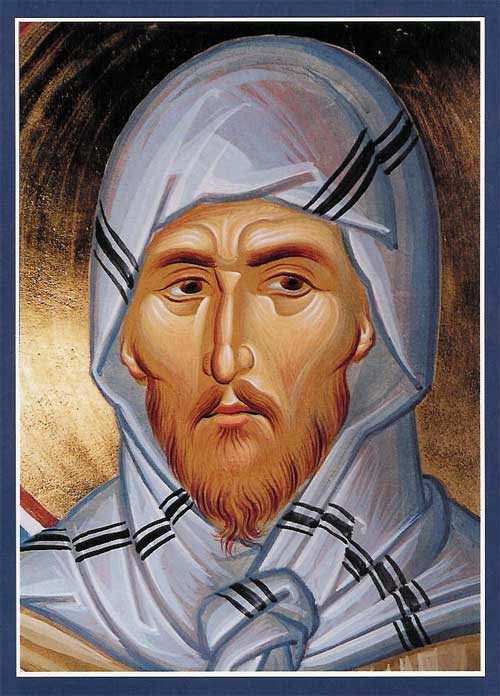
This entry was posted on Thursday, December 4th, 2014 at 1:51 am
You can follow any responses to this entry through the RSS 2.0 feed.
[powerpress]
From The Statement of Faith by St. John Damascene, priest
You have called me, Lord, to minister to your people
O Lord, you led me from my father’s loins and formed me in my mother’s womb. You brought me, a naked babe, into the light of day, for nature’s laws always obey your commands.
By the blessing of the Holy Spirit, you prepared my creation and my existence, not because man willed it or flesh desired it, but by your ineffable grace. The birth you prepared for me was such that it surpassed the laws of our nature. You sent me forth into the light by adopting me as your son and you enrolled me among the children of your holy and spotless Church.
You nursed me with the spiritual milk of your divine utterances. You kept me alive with the solid food of the body of Jesus Christ, your only-begotten Son for our redemption. And he undertook the task willingly and did not shrink from it. Indeed, he applied himself to it as though destined for sacrifice, like an innocent lamb. Although he was God, he became man, and in his human will, became obedient to you, God his Father, unto death, even death on a cross.
In this way you have humbled yourself, Christ my God, so that you might carry me, your stray sheep, on your shoulders. You let me graze in green pastures, refreshing me with the waters of orthodox teaching at the hands of your shepherds. You pastured these shepherds, and now they in turn tend your chosen and special flock. Now you have called me, Lord, by the hand of your bishop to minister to your people. I do not know why you have done so, for you alone know that. Lord, lighten the heavy burden of the sins through which I have seriously transgressed. Purify my mind and heart. Like a shining lamp, lead me along the straight path. When I open my mouth, tell me what I should say. By the fiery tongue of your Spirit make my own tongue ready. Stay with me always and keep me in your sight.
Lead me to pastures, Lord, and graze there with me. Do not let my heart lean either to the right or to the left, but let your good Spirit guide me along the straight path. Whatever I do, let it be in accordance with your will, now until the end.
And you, O Church, are a most excellent assembly, the noble summit of perfect purity, whose assistance comes from God. You in whom God lives, receive from us an exposition of the faith that is free from error, to strengthen the Church, just as our Fathers handed it down to us.
Excerpts from the English translation of The Liturgy of the Hours (Four Volumes) © 1974, International Commission on English in the Liturgy Corporation. All rights reserved.
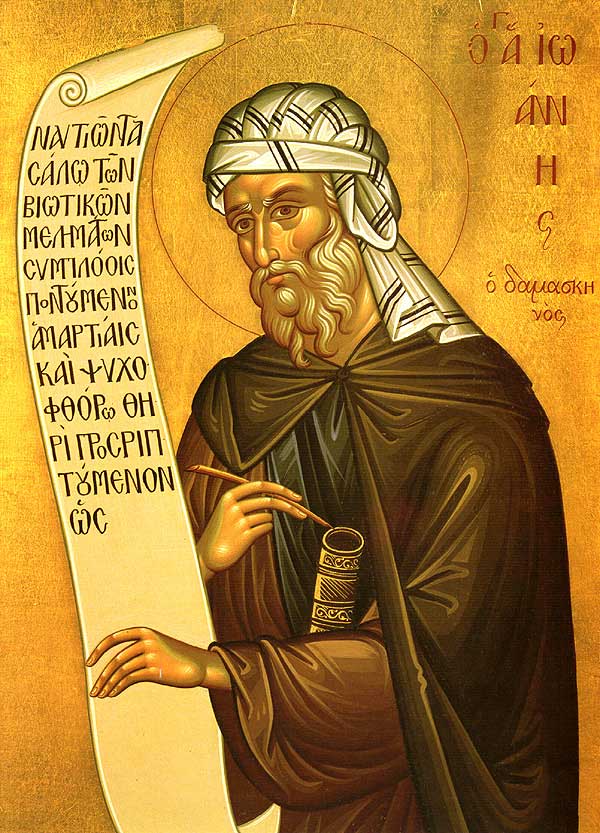
This entry was posted on Thursday, December 4th, 2014 at 12:44 am
You can follow any responses to this entry through the RSS 2.0 feed.
Learn more about St. Jerome in our fascinating discussion with Mike Aquilina
[powerpress]
Spiritual Writings:
 - Letters
-Â The Perpetual Virginity of Blessed Mary
-Â To Pammachius Against John of Jerusalem
-Â The Dialogue Against the Luciferians
-Â The Life of Malchus, the Captive Monk
-Â The Life of S. Hilarion
-Â The Life of Paulus the First Hermit
-Â Against Jovinianus
-Â Against Vigilantius
-Â Against the Pelagians
-Â Prefaces
-Â De Viris Illustribus (Illustrious Men)
-Â Apology for himself against the Books of Rufinus
Prayer to St. Jerome
 For Insight
Through your anger and confrontations you remind us that we all have a duty to confront others from time to time. You also remind us that we have a duty to examine ourselves and confront our own weaknesses and harmful behaviours. Your life teaches that I must accept others for who they are. You taught of the danger of self-righteousness; of the importance of reflecting upon one of Jesus’ most insightful teachings: “Let the man who has no sin on his conscience throw the first stone.” In the light of your teachings, Saint Jerome, help me to see my own self clearly. Help me to confront my own biases and to act to change others only out of love. If I see that I have the duty to confront another, I ask you to be with me during those necessary but unpleasant moments of confrontation. Help me to remember that love alone can make changes for the good.
Amen.
The Thunderer
God’s angry man, His crotchety scholar
Was Saint Jerome,Â
The great name-caller
Who cared not a dime
For the laws of Libel
And in his spare time
Translated the Bible.
Quick to disparage
All joys but learning
Jerome thought marriage
Better than burning;
But didn’t like woman’s
Painted cheeks;
Didn’t like Romans,
Didn’t like Greeks,
Hated Pagans
For their Pagan ways,
Yet doted on Cicero all of his days.
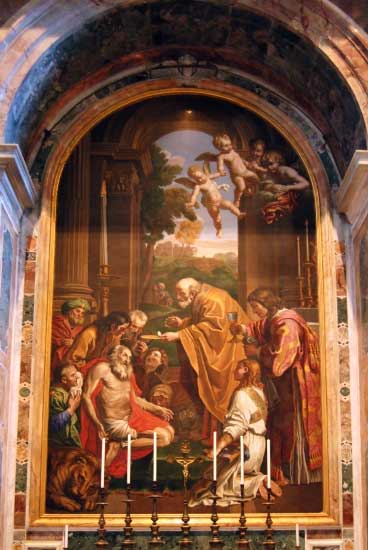
A born reformer, cross and gifted,
He scolded mankind
Sterner than Swift did;
Worked to save
The world from the heathen;
Fled to a cave
For peace to breathe in,
Promptly wherewith
For miles around
He filled the air with
Fury and sound.
In a mighty prose
For Almighty ends,
He thrust at his foes,
Quarreled with his friends,
And served his Master,
Though with complaint.
He wasn’t a plaster sort of a saint.
But he swelled men’s minds
With a Christian leaven.
It takes all kinds
To make a heaven
by Phyllis McGinley, from “Times Three: Selected Verse from Three Decades with Seventy New Poems”, (Pulitzer Prize Winner).
Tags: catholic, catholic podcast, catholic prayer, cathollc spirituality, father, fathers mike, love, mike aquilina, phyllis mcginley, saint jerome, St Jerome
This entry was posted on Tuesday, September 30th, 2014 at 12:13 pm
You can follow any responses to this entry through the RSS 2.0 feed.
[powerpress] An anti-pope who is considered a father of the Church and a saint. God’s great  mercy knows no bounds! How does someone who was a self proclaimed pope (and considered the first
mercy knows no bounds! How does someone who was a self proclaimed pope (and considered the first 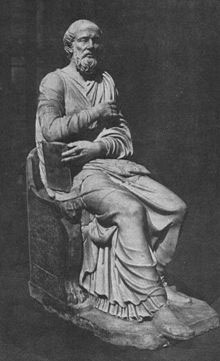 anti-pope in Church history) become a saint? The story of St. Hippolytus is a fascinating one. A greek-speaking priest who who lived in the late 100’s – early 200’s; his writings on the Eucharistic liturgy are some of the most beautiful of all time. Check him out Mike Aquilina’s great blog The Way of the Fathers
anti-pope in Church history) become a saint? The story of St. Hippolytus is a fascinating one. A greek-speaking priest who who lived in the late 100’s – early 200’s; his writings on the Eucharistic liturgy are some of the most beautiful of all time. Check him out Mike Aquilina’s great blog The Way of the Fathers
For more audio from Mike’s visit his Discerning Hearts page
Tags: catholic, catholic podcast, catholic prayer, cathollc spirituality, Church, father, fathers of the church, mercy, mike aquilina, osv, st. paul center for biblical theology
This entry was posted on Wednesday, August 13th, 2014 at 11:43 am
You can follow any responses to this entry through the RSS 2.0 feed.
Bruce and I had a great conversation with Mike Aquilina about the great St. Benedict.
[powerpress]
Here is a teaching from another Benedict our Holy Father Pope Benedict XVI
St Peter’s Square
Wednesday, 9 April 2008
Dear Brothers and Sisters,
Today, I would like to speak about Benedict, the Founder of Western Monasticism and also the Patron of my Pontificate. I begin with words that St Gregory the Great wrote about St Benedict: “The man of God who shone on this earth among so many miracles was just as brilliant in the eloquent exposition of his teaching” (cf. Dialogues II, 36). The great Pope wrote these words in 592 A.D. The holy monk, who had died barely 50 years earlier, lived on in people’s memories and especially in the flourishing religious Order he had founded. St Benedict of Norcia, with his life and his work, had a fundamental influence on the development of European civilization and culture. The most important source on Benedict’s life is the second book of St Gregory the Great’s Dialogues. It is not a biography in the classical sense. In
accordance with the ideas of his time, by giving the example of a real man – St Benedict, in this case – Gregory wished to illustrate the ascent to the peak of contemplation which can be achieved by those who abandon themselves to God. He therefore gives us a model for human life in the climb towards the summit of perfection. St Gregory the Great also tells in this book of the Dialogues of many miracles worked by the Saint, and here too he does not merely wish to recount something curious but rather to show how God, by admonishing, helping and even punishing, intervenes in the practical situations of man’s life. Gregory’s aim was to demonstrate that God is not a distant hypothesis placed at the origin of the world but is present in the life of man, of every man.
This perspective of the “biographer” is also explained in light of the general context of his time: straddling the fifth and sixth centuries, “the world was overturned by a tremendous crisis of values and institutions caused by the collapse of the Roman Empire, the invasion of new peoples and the decay of morals”. But in this terrible situation, here, in this very city of Rome, Gregory presented St Benedict as a “luminous star” in order to point the way out of the “black night of history” (cf. John Paul II, 18 May 1979).
In fact, the Saint’s work and particularly his Rule were to prove heralds of an authentic spiritual leaven which, in the course of the centuries, far beyond the boundaries of his country and time, changed the face of Europe following the fall of the political unity created by the Roman Empire, inspiring a new spiritual and cultural unity, that of the Christian faith shared by the peoples of the Continent. This is how the reality we call “Europe” came into being.
St Benedict was born around the year 480. As St Gregory said, he came “ex provincia Nursiae” – from the province of Norcia. His well-to-do parents sent him to study in Rome. However, he did not stay long in the Eternal City. As a fully plausible explanation, Gregory mentions that the young Benedict was put off by the dissolute lifestyle of many of his fellow students and did not wish to make the same mistakes. He wanted only to please God: “soli Deo placere desiderans” (II Dialogues, Prol. 1). Thus, even before he finished his studies, Benedict left Rome and withdrew to the solitude of the mountains east of Rome. After a short stay in the village of Enfide (today, Affile), where for a time he lived with a “religious community” of monks, he became a hermit in the neighbouring locality of Subiaco. He lived there completely alone for three years in a cave which has been the heart of a Benedictine Monastery called the “Sacro Speco” (Holy Grotto) since the early Middle Ages. The period in Subiaco, a time of solitude with God, was a time of maturation for Benedict. It was here that he bore and overcame the three fundamental temptations of every human being: the temptation of self-affirmation and the desire to put oneself at the centre, the temptation of sensuality and, lastly, the temptation of anger and revenge. In fact, Benedict was convinced that only after overcoming these temptations would he be able to say a useful word to others about their own situations of neediness. Thus, having tranquilized his soul, he could be in full control of the drive of his ego and thus create peace around him. Only then did he decide to found his first monasteries in the Valley of the Anio, near Subiaco.
In the year 529, Benedict left Subiaco and settled in Monte Cassino. Some have explained this move as an escape from the intrigues of an envious local cleric. However, this attempt at an explanation hardly proved convincing since the latter’s sudden death did not induce Benedict to return (II Dialogues, 8). In fact, this decision was called for because he had entered a new phase of inner maturity and monastic experience. According to Gregory the Great, Benedict’s exodus from the remote Valley of the Anio to Monte Cassio – a plateau dominating the vast surrounding plain which can be seen from afar – has a symbolic character: a hidden monastic life has its own raison d’être but a monastery also has its public purpose in the life of the Church and of society, and it must give visibility to the faith as a force of life. Indeed, when Benedict’s earthly life ended on 21 March 547, he bequeathed with his Rule and the Benedictine family he founded a heritage that bore fruit in the passing centuries and is still bearing fruit throughout the world. (more…)
Tags: benedictines, catholic, catholic podcast, catholic prayer, cathollc spirituality, Europe, mike aquilina, Roman Empire, st benedict, st. paul center for biblical theology
This entry was posted on Friday, July 11th, 2014 at 5:02 am
You can follow any responses to this entry through the RSS 2.0 feed.
 Mike Aquilina give us an overview of the great saints life and impact on the Church
Mike Aquilina give us an overview of the great saints life and impact on the Church
[powerpress]
St. John of Damascus, not only taught that icons and other sacred artworks are permissible because they point to the incarnation of Jesus, but he also understood the rich value of every word to do the same. He is considered one of the Church’s most gifted poets. Every sacred image, whether in art, hymn, poetry can be a prayer that leads us deeper into the heart of God.
The St. John Damascus site contains many of his writings…it’s fantastic!
“RIGHTEOUS JOHN OF DAMASCUS. He was raised in Damascus, Syria, the capital of the Moslem world. When he was ten years of age, his father found a learned monk in the secular studies as well as music and theology. He instructed John and his adopted brother, Cosmas, and John made great progress in theology. At last, the monk departed saying to their father, Sergius, that his sons had become remarkably wise. Sergius soon died, and John was chosen for his office of counselor to the caliph.
During this time, John wrote convincingly against the iconoclasts and Leo the Armenian, as well as the Moslems. He effectively used deductive arguments, history, and parables of the saints. Against the iconoclasts, he argued that since the shadows and handkerchiefs of the apostles healed the sick, why was it not appropriate to venerate their icons. His letters were circulated to strengthen and prepare the people to answer the attacks of the heretics. Seeing this, the emperor wrote a letter in John’s hand that had him condemned to the caliph for whom he worked. The caliph had his right hand cut off and hung in the market place. That night, John recovered his hand and prayed before an icon of the Theotokos, called of the three hands, promising that he would write hymns for Orthodoxy if he were healed. He slept, and she told him that he was healed and to write. The caliph freed him, and he became a humble monk. He wrote canons, troparia, idiomela, festal homilies for feast days of Jesus and the Theotokos, the saints and prophets. He established the Typikon, the order of services. He became the mouth piece of all the bishops of the east. He died peacefully at 104 years of age.” – from the St. John of Damascus Institute site – for a longer account go there
Spiritual Writings:
Exposition of the Faith
The video contains some of St. John Damascus’ teachings on the Blessed Virgin Mary
A Prayer of St. John of Damascus
I stand before the gates of thy Temple, and yet I refrain not from my evil thoughts. But do thou, O Christ my God, who didst justify the publican, and hadst mercy on the Canaanite woman, and opened the gates of Paradise to the thief; open unto me the compassion of thy love toward mankind, and receive me as I approach and touch thee, like the sinful woman and the woman with the issue of blood; for the one, by embracing thy feet received the forgiveness of her sins, and the other by but touching the hem of thy garment was healed. And I, most sinful, dare to partake of thy whole Body. Let me not be consumed but receive me as thou didst receive them, and enlighten the perceptions of my soul, consuming the accusations of my sins; through the intercessions of Her that without stain gave Thee birth, and of the heavenly Powers; for thou art blessed unto ages of ages. Amen.
Tags: art, Church, father, fathers mike, icons, john of damascus, mike aquilina, sacred image, secular studies, st john of damascus
This entry was posted on Wednesday, December 4th, 2013 at 12:34 am
You can follow any responses to this entry through the RSS 2.0 feed.
The story and history of Saint Clement.
![]() First, start with the podcast above featuring the son of the Fathers, Mike Aquilina talking about St. Clement, then…
First, start with the podcast above featuring the son of the Fathers, Mike Aquilina talking about St. Clement, then…
Clemens Romanus was born in Rome in Italy during the time that the Christian faith was being spread and Christians were being persecuted by the Roman Emperors. He is believed to be of Jewish descent and a freeman of Rome. He worked as a tanner
during the early part of his life. He was then converted to Christianity and became a disciple of St. Peter and of St. Paul. Following the death of Saint Peter he took over his position and became the fourth Pope and Bishop of Rome continuing to convert Romans from the religion of the old Roman gods to Christianity.
Saint Clement was banished from Rome during the reign of the Emperor Trajan (September 18, 53 – August 9, 117) due to his beliefs and unpopularity with the Roman rabble. He was banished to Chersonesus, which was an ancient Greek colony under Roman rule, in the south western part of Crimea (part of the Ukraine). In Chersonesus he was sentenced to work with other prisoners in a sto
ne quarry where he continued to convert people. The number and success of his conversions attracted the attention of the Roman prefect who sentenced him to death. Clement was he was bound to an anchor and cast into the sea. He died in A.D.100.
How blessed and amazing are God’s gifts, dear friends Life with immortality, splendor with righteousness, truth with confidence, faith with assurance, self-control with holiness And all these things are within our comprehension. Clement of Rome

Basilica of Saint Clement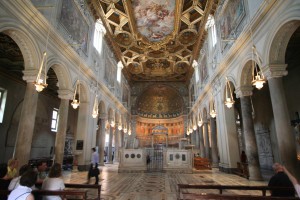
The Basilica di San Clemente is an early Christian basilica in Rome dedicated to Pope St. Clement. Its beautiful interior is especially notable for its three historical layers.
The main upper church is one of the most richly decorated churches in Rome. The vast majority of its architecture and art dates from its construction in the early 12th century. The entrance is on the left aisle.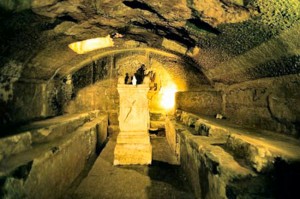
The most striking sight is the 12th-century apse mosaic, in a golden-bronze color and featuring a large cross in the center. In the center of the apse is a throne, whose back is part of a martyr’s tomb.
The high altar contains the relics of St. Clement of Rome and St. Ignatius of Antioch. Faded frescoes decorate many of the walls, and date from the 6th to 11th centuries. They depict New Testament scenes and lives of several saints.
Tags: basilica di san clemente, Church, churches in rome, clement of rome, emperor trajan, father of the church, fathers mike, mike aquilina, rome, saint clement, st clement of rome
This entry was posted on Saturday, November 23rd, 2013 at 12:02 am
You can follow any responses to this entry through the RSS 2.0 feed.
 Mike Aquilina shares with Bruce and I the life and teaches of St. John Chrysostom.
Mike Aquilina shares with Bruce and I the life and teaches of St. John Chrysostom.
[powerpress]
John Chrysostom born in 347, his father died soon after his birth, leaving his mother,  Anthusa, a widow at the age of 20.  She never married, sticking with the teachings of St. Paul to stay unmarried; she was a devout Christian and was very committed to her son; they loved and cared for each other very much. She would raise up a son who had a great love for Jesus Christ and who would become of the greatest preachers of all time (imagine him the Billy Graham of his day). He would become the Archbishop of Constantinople, and an important Early Church Father. His denunciation of abuse of authority by both ecclesiastical and political leaders would get him in big trouble, but it didn’t stop him. After his death (or, according to some sources, during his life) he was given the Greek surname chrysostomos, meaning “golden mouthed”, rendered in English as Chrysostom.
Many Christian Churches love and claim St. John Chrysostom. The Orthodox and Eastern Catholic Churches honor him as a saint and count him among the Three Holy Hierarchs, together with Saints Basil the Great and Gregory Nazianzus. He is recognized by the Eastern Orthodox Church and Roman Catholic Church as a saint and Doctor of the Church. Churches of the Western tradition, including the Roman Catholic Church, some Anglican provinces, and parts of the Lutheran Church, commemorate him on 13 September. Some Lutheran and many Anglican provinces commemorate him on the traditional Eastern feast day of 27 January. The Coptic Orthodox Church of Alexandria recognizes John Chrysostom as a saint.
Spiritual Writings:
 - Homilies on the Gospel of St. Matthew
-Â Homilies on Acts
-Â Homilies on Romans
-Â Homilies on First Corinthians
-Â Homilies on Second Corinthians
-Â Homilies on Ephesians
-Â Homilies on Philippians
-Â Homilies on Colossians
-Â Homilies on First Thessalonians
-Â Homilies on Second Thessalonians
-Â Homilies on First Timothy
-Â Homilies on Second Timothy
-Â Homilies on Titus
-Â Homilies on Philemon
-Â Commentary on Galatians
-Â Homilies on the Gospel of John
-Â Homilies on the Epistle to the Hebrews
-Â Homilies on the Statues
-Â No One Can Harm the Man Who Does Not Injure Himself
-Â Two Letters to Theodore After His Fall
-Â Letter to a Young Widow
-Â Homily on St. Ignatius
-Â Homily on St. Babylas
-Â Homily Concerning “Lowliness of Mind”
-Â Instructions to Catechumens
-Â Three Homilies on the Power of Satan
-Â Homily on the Passage “Father, if it be possible . . .”
-Â Homily on the Paralytic Lowered Through the Roof
-Â Homily on the Passage “If your enemy hunger, feed him.”
-Â Homily Against Publishing the Errors of the Brethren
-Â First Homily on Eutropius
-Â Second Homily on Eutropius (After His Captivity)
-Â Four Letters to Olympias
-Â Letter to Some Priests of Antioch
-Â Correspondence with Pope Innocent I
-Â On the Priesthood.
.
Prayer is the light of the soul
A reading from the homilies of St John Chrysostom (Hom 6 on Prayer)
“There is nothing more worthwhile than to pray to God and to converse with him, for prayer unites us with God as his companions. As our bodily eyes are illuminated by seeing the light, so in contemplating God our soul is illuminated by him. Of course the prayer I have in mind is no matter of routine, it is deliberate and earnest. It is not tied down to a fixed timetable; rather it is a state which endures by night and day.
Our soul should be directed in God, not merely when we suddenly think of prayer, but even when we are concerned with something else. If we are looking after the poor, if we are busy in some other way, or if we are doing any type of good work, we should season our actions with the desire and the remembrance of God. Through this salt of the love of God we can all become a sweet dish for the Lord. If we are generous in giving time to prayer, we will experience its benefits throughout our life.
Prayer is the light of the soul, giving us true knowledge of God. It is a link mediating between God and man. By prayer the soul is borne up to heaven and in a marvellous way embraces the Lord. This meeting is like that of an infant crying on its mother, and seeking the best of milk. The soul longs for its own needs and what it receives is better than anything to be seen in the world.
Prayer is a precious way of communicating with God, it gladdens the soul and gives repose to its affections. You should not think of prayer as being a matter of words. It is a desire for God, an indescribable devotion, not of human origin, but the gift of God’s grace. As Saint Paul says: we do not know how to pray as we ought, but the Spirit himself intercedes for us with sighs too deep for words.
Anyone who receives from the Lord the gift of this type of prayer possesses a richness that is not to be taken from him, a heavenly food filling up the soul. Once he has tasted this food, he is set alight by an eternal desire for the Lord, the fiercest of fires lighting up his soul.
To set about this prayer, paint the house of your soul with modesty and lowliness and make it splendid with the light of justice. Adorn it with the beaten gold of good works and, for walls and stones, embellish it assiduously with faith and generosity. Above all, place prayer on top of this house as its roof so that the complete building may be ready for the Lord. Thus he will be received in a splendid royal house and by grace his image will already be settled in your soul.
Â
Tags: doctor of the church, eastern catholic churches, father of the church, fathers mike, heaven, John Chrysostom, mike aquilina, mother, prayer, st john chrysostom
This entry was posted on Friday, September 13th, 2013 at 7:12 am
You can follow any responses to this entry through the RSS 2.0 feed.
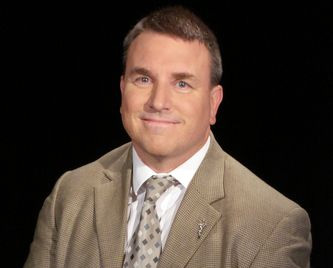 Episode 15 – Great Works in Western Literature with Joseph Pearce – St. Augustine
Episode 15 – Great Works in Western Literature with Joseph Pearce – St. Augustine
[powerpress]
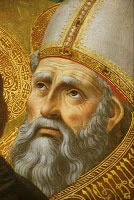 The Confessions of Saint Augustine is considered one of the greatest Christian classics of all time. It is an extended poetic, passionate, intimate prayer that Augustine wrote as an autobiography sometime after his conversion, to confess his sins and proclaim God’s goodness. Just as his first hearers were captivated by his powerful conversion story, so also have many millions been over the following sixteen centuries. His experience of God speaks to us across time with little need of transpositions.
The Confessions of Saint Augustine is considered one of the greatest Christian classics of all time. It is an extended poetic, passionate, intimate prayer that Augustine wrote as an autobiography sometime after his conversion, to confess his sins and proclaim God’s goodness. Just as his first hearers were captivated by his powerful conversion story, so also have many millions been over the following sixteen centuries. His experience of God speaks to us across time with little need of transpositions.
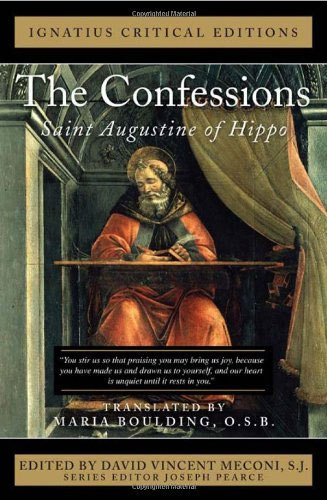 Based on the Ignatius Critical Edition, this series examines, from the Judeo-Christian perspective, the life, the times, and influence of authors of great works in literature .
Based on the Ignatius Critical Edition, this series examines, from the Judeo-Christian perspective, the life, the times, and influence of authors of great works in literature .
Joseph Pearce is currently the Writer-in-Residence and Visiting Fellow at Thomas More College of Liberal Arts in Merrimack, New Hampshire. He is also Visiting Scholar at Mount Royal Academy in Sunapee, New Hampshire. He is also Visiting Scholar at Mount Royal Academy in Sunapee, New Hampshire. He is  co-editor of the Saint Austin Review (or StAR), an international review of Christian culture, literature, and ideas published in England (Family Publications) and the United States (Sapientia Press). He is also the author of many books, including literary biographies of Solzhenitsyn, J. R. R. Tolkien, C. S. Lewis, G. K. Chesterton, and Oscar Wilde.
To learn more about the authors and titles available in the Ignatius Critical Editions
Tags: catholic, catholic podcast, catholic prayer, cathollc spirituality, conversion, joseph pearce, New Hampshire, prayer
This entry was posted on Tuesday, September 3rd, 2013 at 8:28 am
You can follow any responses to this entry through the RSS 2.0 feed.
We talk with Mike Aquilina  about St. Gregor the Great, a father of the Church.
 [powerpress]
[powerpress]
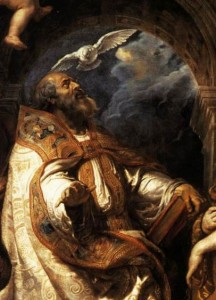 St. Gregory the Great…the tradition of the Church considers him one of the four great doctors of the Latin Church. Born in Rome, Italy, in AD 540, St. Gregory was the son of Gordianus, a wealthy senator, and Silvia, who later became a saint. (Saints make saints after all…).
St. Gregory the Great…the tradition of the Church considers him one of the four great doctors of the Latin Church. Born in Rome, Italy, in AD 540, St. Gregory was the son of Gordianus, a wealthy senator, and Silvia, who later became a saint. (Saints make saints after all…).
His youth was a troubled one. In his writings he chronicles the perpetual seiges that Rome endured at the hands of the barbarians.  Those nasty Lombards! Pillaging, raping, massacring, they would plague the Church and the people of the land for 200 years, you name it..by any standard, they were bad!
Saint Gregory became the Prefect of Rome at the age of thirty, and the people loved him because he was able to keep them safe. A few years later, like his parents, he gave his wealth away. He became a Benedictine monk. But the pope of the time, recalled him to Rome to serve as a deacon and to help the city, which was again attacked by the Lombards.
On the third day of September in 590, after he had first been ordained a priest, Saint Gregory was consecrated Pope and Bishop of Rome, in Saint Peter’s Basilica. He was the first monk to become Pope.  The Holy Spirit didn’t waste anytime moving him to service!
Through Saint Leander and his brother, Saint Isidore of Seville, as well as the martyr  Saint Hermenegild, Saint Gregory recovered Spain from the Arians. Through Queen Theodelinda, the wife of the Lombard King Agilulf, he was able to begin the conversion of the Lombard nation and the tempering of their ferocious and cruel natures. He won France back and began conversions in England. Saint Gregory was, above all else, a vigilant guardian of the Church’s doctrine, always the mark of a holy Pope. He ordained, early in his pontificate that the first four Ecumenical Councils of the Church should be treated with the respect given to the four Gospels. He worked unceasingly to stamp out heresy. He ordered that at the beginning of Lent the blessed ashes should be placed on the foreheads of the faithful, instead of only the head of the Pope — as had been the custom up to that time — and that the priest should repeat to each one, “Remember man, that dust thou art, and unto dust thou shalt return”. excerpted in part from an article by Sister Catherine Goddard Clark, M.I.C.M.
Saint Hermenegild, Saint Gregory recovered Spain from the Arians. Through Queen Theodelinda, the wife of the Lombard King Agilulf, he was able to begin the conversion of the Lombard nation and the tempering of their ferocious and cruel natures. He won France back and began conversions in England. Saint Gregory was, above all else, a vigilant guardian of the Church’s doctrine, always the mark of a holy Pope. He ordained, early in his pontificate that the first four Ecumenical Councils of the Church should be treated with the respect given to the four Gospels. He worked unceasingly to stamp out heresy. He ordered that at the beginning of Lent the blessed ashes should be placed on the foreheads of the faithful, instead of only the head of the Pope — as had been the custom up to that time — and that the priest should repeat to each one, “Remember man, that dust thou art, and unto dust thou shalt return”. excerpted in part from an article by Sister Catherine Goddard Clark, M.I.C.M.
He is known for his magnificent contributions to the Liturgy of the Mass and Office. The “Gregorian Chant” is named in honor of Saint Gregory’s patient labor in restoring the ancient chant of the Church and in setting down the rules to be followed so that Church music might more perfectly fulfill its function.
Saint Gregory the Great died on the twelfth of March, 604, at the age of sixty-four. He was canonized immediately after his death. Later, because of the volume, the extraordinary insight and the profundity of his writings, the depth and extent of his learning, and the heroic holiness of his life, the Church gratefully placed him beside Jerome and Ambrose and Augustine. Saint Gregory the Great became the fourth of the Church’s four great Doctors of the West. –
What would today be like without a little Gregorian Chant in honor of our St. Gregory?
 Spiritual Writings:
-Â Pastoral Rule
-Â Register of Letters
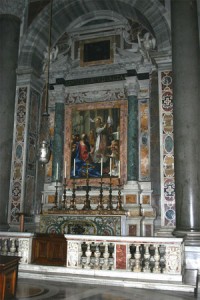 The altar of St. Gregory the Great at St. Peter’s in Rome. One of my favorite places to pray at the Vatican.Â
The altar of St. Gregory the Great at St. Peter’s in Rome. One of my favorite places to pray at the Vatican.Â
Tags: benedictine monk, bishop of rome, Church, ecumenical councils of the church, fathers mike, holy spirit, Latin Church, our sunday visitor, rome, saint gregory
This entry was posted on Tuesday, September 3rd, 2013 at 12:01 am
You can follow any responses to this entry through the RSS 2.0 feed.
Join us a we discuss the life St. Justin Martyr with the wonderful Mike Aquilina
[powerpress]
You can also read the following from Vatican.va
BENEDICT XVI
GENERAL AUDIENCE
St Peter’s Square
Wednesday, 21 March 2007
St Justin, Philosopher and Martyr (c. 100-165)
Dear Brothers and Sisters,
In these Catecheses, we are reflecting on the great figures of the early Church. Today, we will talk about St Justin, Philosopher and Martyr, the most important of the second-century apologist Fathers.
The word “apologist” designates those ancient Christian writers who set out to defend the new religion from the weighty accusations of both pagans and Jews, and to spread the Christian doctrine in terms suited to the culture of their time.
Thus, the apologists had a twofold concern: that most properly called “apologetic”, to defend the newborn Christianity (apologhÃa in Greek means, precisely, “defence”), and the pro-positive, “missionary” concern, to explain the content of the faith in a language and on a wavelength comprehensible to their contemporaries.
Justin was born in about the year 100 near ancient Shechem, Samaria, in the Holy Land; he spent a long time seeking the truth, movi
Finally, as he himself recounts in the first chapters of his Dialogue with Tryphon, a mysterious figure, an old man he met on the seashore, initially leads him into a crisis by showing him that it is impossible for the human being to satisfy his aspiration to the divine solely with his own forces. He then pointed out to him the ancient prophets as the people to turn to in order to find the way to God and “true philosophy”.ng through the various schools of the Greek philosophical tradition.In taking his leave, the old man urged him to pray that the gates of light would be opened to him.
The story foretells the crucial episode in Justin’s life: at the end of a long philosophical journey, a quest for the truth, he arrived at the Christian faith. He founded a school in Rome where, free of charge, he initiated students into the new religion, considered as the true philosophy. Indeed, in it he had found the truth, hence, the art of living virtuously.For this reason he was reported and beheaded in about 165 during the reign of Marcus Aurelius, the philosopher-emperor to whom Justin had actually addressed one of his Apologia.
These - the two Apologies and the Dialogue with the Hebrew, Tryphon - are his only surviving works. In them, Justin intends above all to illustrate the divine project of creation and salvation, which is fulfilled in Jesus Christ, the Logos, that is, the eternal Word, eternal Reason, creative Reason. (more…)
Tags: catholic, catholic podcast, catholic prayer
This entry was posted on Saturday, June 1st, 2013 at 10:01 am
You can follow any responses to this entry through the RSS 2.0 feed.

